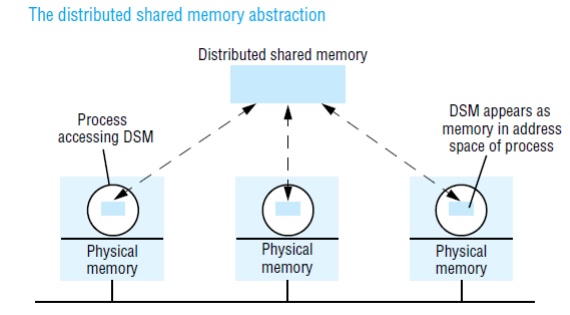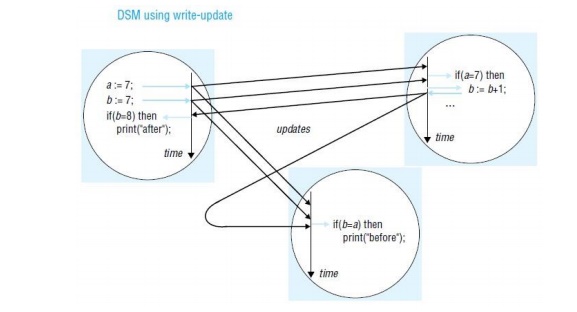Chapter: Distributed Systems : Process & Resource Management
Distributed Shared Memory
DISTRIBUTED SHARED MEMORY
Distributed
shared memory (DSM) is an abstraction used for sharing data between computers
that do not share physical memory. Processes access DSM by reads and updates to
what appears to be ordinary memory within their address space. However, an
underlying runtime system ensures transparently that processes executing at
different computers observe the updates made by one another.
The main
point of DSM is that it spares the programmer the concerns of message passing
when writing applications that might otherwise have to use it. DSM is primarily
a tool for parallel applications or for any distributed application or group of
applications in which individual shared data items can be accessed directly.
DSM is in general less appropriate in client-server systems, where clients
normally view server-held resources as abstract data and access them by request
(for reasons of modularity and protection).

Message
passing cannot be avoided altogether in a distributed system: in the absence of
physically shared memory, the DSM runtime support has to send updates in
messages between computers. DSM systems manage replicated data: each computer
has a local copy of recently accessed data items stored in DSM, for speed of
access.
In
distributed memory multiprocessors and clusters of off-the-shelf computing
components (see Section 6.3), the processors do not share memory but are
connected by a very high-speed network. These systems, like general-purpose
distributed systems, can scale to much greater numbers of processors than a
shared-memory multiprocessor’s 64 or so. A central question that has been
pursued by the DSM and multiprocessor research communities is whether the
investment in knowledge of shared memory algorithms and the associated software
can be directly transferred to a more scalable distributed memory architecture.
Message passing versus DSM
As a
communication mechanism, DSM is comparable with message passing rather than
with request-reply-based communication, since its application to parallel
processing, in particular, entails the use of asynchronous communication. The
DSM and message passing approaches to programming can be contrasted as follows:
Programming model:
Under the
message passing model, variables have to be marshalled from one process,
transmitted and unmarshalled into other variables at the receiving process. By
contrast, with shared memory the processes involved share variables directly,
so no marshalling is necessary – even of pointers to shared variables – and
thus no separate communication operations are necessary.
Efficiency :
Experiments
show that certain parallel programs developed for DSM can be made to perform
about as well as functionally equivalent programs written for message passing
platforms on the same hardware – at least in the case of relatively small numbers
of computers (ten or so). However, this result cannot be generalized. The
performance of a program based on DSM depends upon many factors, as we shall
discuss below – particularly the pattern of data sharing.
Implementation approaches to DSM
Distributed
shared memory is implemented using one or a combination of specialized
hardware, conventional paged virtual memory or middleware:
Hardware:
Shared-memory
multiprocessor architectures based on a NUMA architecture rely on specialized
hardware to provide the processors with a consistent view of shared memory.
They handle memory LOAD and STORE instructions by communicating with remote
memory and cache modules as necessary to store and retrieve data.
Paged
virtual memory:
Many
systems, including Ivy and Mether , implement DSM as a region of virtual memory
occupying the same address range in the address space of every participating
process.
#include "world.h"
struct shared { int a, b; }; Program Writer:
main()
{
struct shared *p;
methersetup(); /* Initialize the Mether runtime */
p = (struct shared *)METHERBASE;
/* overlay structure on METHER segment */ p->a =
p->b = 0; /* initialize fields to zero */
while(TRUE){ /* continuously update structure
fields */ p –>a = p –>a + 1;
p –>b = p –>b - 1;
}
}
Program Reader:
main()
{
struct shared *p; methersetup();
p = (struct shared *)METHERBASE;
while(TRUE){ /* read the fields once every second
*/ printf("a = %d, b = %d\n", p –>a, p –>b);
sleep(1);
}
}
Middleware:
Some
languages such as Orca, support forms of DSM without any hardware or paging
support, in a platform-neutral way. In this type of implementation, sharing is
implemented by communication between instances of the user-level support layer
in clients and servers. Processes make calls to this layer when they access
data items in DSM. The instances of this layer at the different computers
access local data items and communicate as necessary to maintain consistency.
Design and implementation issues
The
synchronization model used to access DSM consistently at the application level;
the DSM consistency model, which governs the consistency of data values
accessed from different computers; the update options for communicating written
values between computers; the granularity of sharing in a DSM implementation;
and the problem of thrashing.
Structure
A DSM
system is just such a replication system. Each application process is presented
with some abstraction of a collection of objects, but in this case the
‘collection’ looks more or less like memory. That is, the objects can be
addressed in some fashion or other. Different approaches to
DSM vary
in what they consider to be an ‘object’ and in how objects are addressed. We
consider three approaches, which view DSM as being composed respectively of
contiguous bytes, language-level objects or immutable data items.
Byte-oriented
This type
of DSM is accessed as ordinary virtual memory – a contiguous array of bytes. It
is the view illustrated above by the Mether system. It is also the view of many
other DSM systems, including Ivy.It allows applications (and language
implementations) to impose whatever data structures they want on the shared
memory. The shared objects are directly addressible memory locations (in
practice, the shared locations may be multi-byte words rather than individual
bytes). The only operations upon those objects are read (or LOAD) and write
(or STORE). If x and y are two memory locations, then we
denote instances of these operations as follows:

Object-oriented
The
shared memory is structured as a collection of language-level objects with
higher-level semantics than simple read
/ write variables, such as stacks and
dictionaries. The contents of the shared memory are changed only by invocations
upon these objects and never by direct access to their member variables. An
advantage of viewing memory in this way is that object semantics can be
utilized when enforcing consistency.
Immutable data
When
reading or taking a tuple from tuple space, a process provides a tuple
specification and the tuple space returns any tuple that matches that
specification – this is a type of associative addressing. To enable processes
to synchronize their activities, the read
and take operations both block until
there is a matching tuple in the tuple space.
Synchronization model
Many
applications apply constraints concerning the values stored in shared memory.
This is as true of applications based on DSM as it is of applications written
for sharedmemory multiprocessors (or indeed for any concurrent programs that
share data, such as operating system kernels and multi-threaded servers). For
example, if a and b are two variables stored in DSM, then
a constraint might be that a=b
always. If two or moreprocesses execute the following code:
a:= a + 1; b := b + 1;
then an
inconsistency may arise. Suppose a
and b are initially zero and that
process 1gets as far as setting a to
1. Before it can increment b, process
2 sets a to 2 and b to 1.
Consistency model
The local
replica manager is implemented by a combination of middleware (the DSM runtime
layer in each process) and the kernel. It is usual for middleware to perform
the majority of DSM processing. Even in a page-based DSM implementation, the
kernel usually provides only basic page mapping, page-fault handling and
communication mechanisms and middleware is responsible for implementing the
page-sharing policies. If DSM segments are persistent, then one or more storage
servers (for example, file servers) will also act as replica managers.

Sequential consistency
A DSM
system is said to be sequentially consistent if for any execution there is some interleaving of the series of
operations issued by all the processes that satisfies the following two
criteria:
SC1: The
interleaved sequence of operations is such that if R(x) a occurs in the
sequence, then either the last write operation that occurs before it in the
interleaved sequence is W(x) a, or no write operation occurs before it and a is the initial value of x.
SC2: The
order of operations in the interleaving is consistent with the program order in
which each individual client executed them.

Coherence
Coherence
is an example of a weaker form of consistency. Under coherence, every process
agrees on the order of write operations to the same location, but they do not
necessarily agree on the ordering of write operations to different locations.
We can think of coherence as sequential consistency on a locationby- location
basis. Coherent DSM can be implemented by taking a protocol for implementing
sequential consistency and applying it separately to each unit of replicated
data – for example, each page.
Weak consistency
This
model exploits knowledge of synchronization operations in order to relax memory
consistency, while appearing to the programmer to implement sequential
consistency (at least, under certain conditions that are beyond the scope of
this book). For example, if the programmer uses a lock to implement a critical
section, then a DSM system can assume that no other process may access the data
items accessed under mutual exclusion within it. It is therefore redundant for
the DSM system to propagate updates to these items until the process leaves the
critical section.
While
items are left with ‘inconsistent’ values some of the time, they are not
accessed at those points; the execution appears to be sequentially consistent.
Update options
Two main
implementation choices have been devised for propagating updates made by one
process to the others: write-update and write-invalidate. These are applicable
to a variety of DSM consistency models, including sequential consistency. In
outline, the options are as follows:
Write-update: The updates made by a process
are made locally and multicast to all other replica managers possessing a copy of the data item, which immediately
modify the data read by local processes. Processes read the local copies of
data items, without the need for communication. In addition to allowing
multiple readers, several processes may write the same data item at the same
time; this is known as multiple-reader/multiple-writer sharing.

Write-invalidate: This is commonly implemented in
the form of multiple-reader/ single-writer
sharing. At any time, a data item may either be accessed in read-only mode
by one or more processes, or it may be read and written by a single process. An
item that is currently accessed in read-only mode can be copied indefinitely to
other processes. When a process attempts to write to it, a multicast message is
first sent to all other copies to invalidate them and this is acknowledged
before the write can take place; the other processes are thereby prevented from
reading stale data (that is, data that are not up to date). Any processes
attempting to access the data item are blocked if a writer exists.
Granularity
An issue
that is related to the structure of DSM is the granularity of sharing.
Conceptually, all processes share the entire contents of a DSM. As programs
sharing DSM execute, however, only certain parts of the data are actually
shared and then only for certain times during the execution. It would clearly
be very wasteful for the DSM implementation always to transmit the entire
contents of DSM as processes access and update it.
Thrashing
A
potential problem with write-invalidate protocols is thrashing. Thrashing is
said to occur where the DSM runtime spends an inordinate amount of time
invalidating and transferring shared data compared with the time spent by
application processes doing useful work. It occurs when several processes
compete for the same data item, or for falsely shared data items.
Related Topics